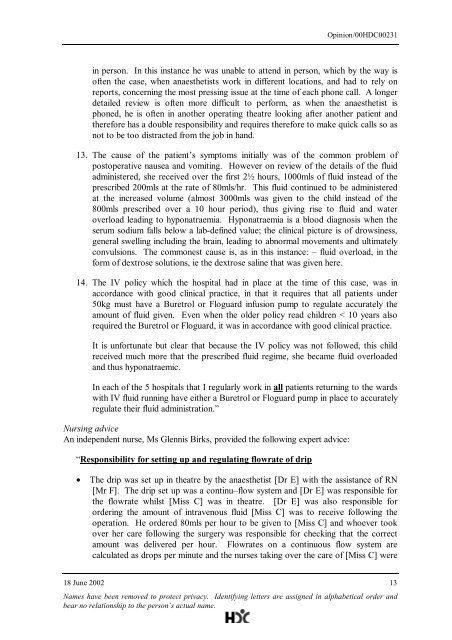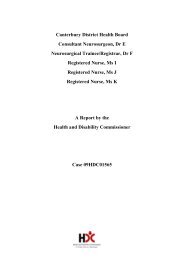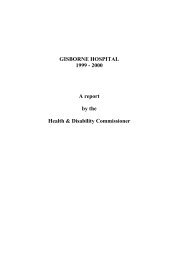Download the pdf version of this decision. - Health and Disability ...
Download the pdf version of this decision. - Health and Disability ...
Download the pdf version of this decision. - Health and Disability ...
You also want an ePaper? Increase the reach of your titles
YUMPU automatically turns print PDFs into web optimized ePapers that Google loves.
Opinion/00HDC00231<br />
in person. In <strong>this</strong> instance he was unable to attend in person, which by <strong>the</strong> way is<br />
<strong>of</strong>ten <strong>the</strong> case, when anaes<strong>the</strong>tists work in different locations, <strong>and</strong> had to rely on<br />
reports, concerning <strong>the</strong> most pressing issue at <strong>the</strong> time <strong>of</strong> each phone call. A longer<br />
detailed review is <strong>of</strong>ten more difficult to perform, as when <strong>the</strong> anaes<strong>the</strong>tist is<br />
phoned, he is <strong>of</strong>ten in ano<strong>the</strong>r operating <strong>the</strong>atre looking after ano<strong>the</strong>r patient <strong>and</strong><br />
<strong>the</strong>refore has a double responsibility <strong>and</strong> requires <strong>the</strong>refore to make quick calls so as<br />
not to be too distracted from <strong>the</strong> job in h<strong>and</strong>.<br />
13. The cause <strong>of</strong> <strong>the</strong> patient’s symptoms initially was <strong>of</strong> <strong>the</strong> common problem <strong>of</strong><br />
postoperative nausea <strong>and</strong> vomiting. However on review <strong>of</strong> <strong>the</strong> details <strong>of</strong> <strong>the</strong> fluid<br />
administered, she received over <strong>the</strong> first 2½ hours, 1000mls <strong>of</strong> fluid instead <strong>of</strong> <strong>the</strong><br />
prescribed 200mls at <strong>the</strong> rate <strong>of</strong> 80mls/hr. This fluid continued to be administered<br />
at <strong>the</strong> increased volume (almost 3000mls was given to <strong>the</strong> child instead <strong>of</strong> <strong>the</strong><br />
800mls prescribed over a 10 hour period), thus giving rise to fluid <strong>and</strong> water<br />
overload leading to hyponatraemia. Hyponatraemia is a blood diagnosis when <strong>the</strong><br />
serum sodium falls below a lab-defined value; <strong>the</strong> clinical picture is <strong>of</strong> drowsiness,<br />
general swelling including <strong>the</strong> brain, leading to abnormal movements <strong>and</strong> ultimately<br />
convulsions. The commonest cause is, as in <strong>this</strong> instance: – fluid overload, in <strong>the</strong><br />
form <strong>of</strong> dextrose solutions, ie <strong>the</strong> dextrose saline that was given here.<br />
14. The IV policy which <strong>the</strong> hospital had in place at <strong>the</strong> time <strong>of</strong> <strong>this</strong> case, was in<br />
accordance with good clinical practice, in that it requires that all patients under<br />
50kg must have a Buretrol or Floguard infusion pump to regulate accurately <strong>the</strong><br />
amount <strong>of</strong> fluid given. Even when <strong>the</strong> older policy read children < 10 years also<br />
required <strong>the</strong> Buretrol or Floguard, it was in accordance with good clinical practice.<br />
It is unfortunate but clear that because <strong>the</strong> IV policy was not followed, <strong>this</strong> child<br />
received much more that <strong>the</strong> prescribed fluid regime, she became fluid overloaded<br />
<strong>and</strong> thus hyponatraemic.<br />
In each <strong>of</strong> <strong>the</strong> 5 hospitals that I regularly work in all patients returning to <strong>the</strong> wards<br />
with IV fluid running have ei<strong>the</strong>r a Buretrol or Floguard pump in place to accurately<br />
regulate <strong>the</strong>ir fluid administration.”<br />
Nursing advice<br />
An independent nurse, Ms Glennis Birks, provided <strong>the</strong> following expert advice:<br />
“Responsibility for setting up <strong>and</strong> regulating flowrate <strong>of</strong> drip<br />
• The drip was set up in <strong>the</strong>atre by <strong>the</strong> anaes<strong>the</strong>tist [Dr E] with <strong>the</strong> assistance <strong>of</strong> RN<br />
[Mr F]. The drip set up was a continu–flow system <strong>and</strong> [Dr E] was responsible for<br />
<strong>the</strong> flowrate whilst [Miss C] was in <strong>the</strong>atre. [Dr E] was also responsible for<br />
ordering <strong>the</strong> amount <strong>of</strong> intravenous fluid [Miss C] was to receive following <strong>the</strong><br />
operation. He ordered 80mls per hour to be given to [Miss C] <strong>and</strong> whoever took<br />
over her care following <strong>the</strong> surgery was responsible for checking that <strong>the</strong> correct<br />
amount was delivered per hour. Flowrates on a continuous flow system are<br />
calculated as drops per minute <strong>and</strong> <strong>the</strong> nurses taking over <strong>the</strong> care <strong>of</strong> [Miss C] were<br />
18 June 2002 13<br />
Names have been removed to protect privacy. Identifying letters are assigned in alphabetical order <strong>and</strong><br />
bear no relationship to <strong>the</strong> person’s actual name.
















